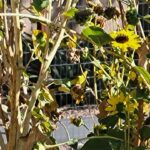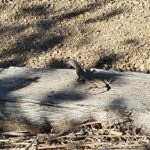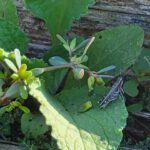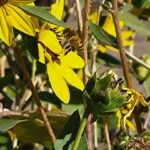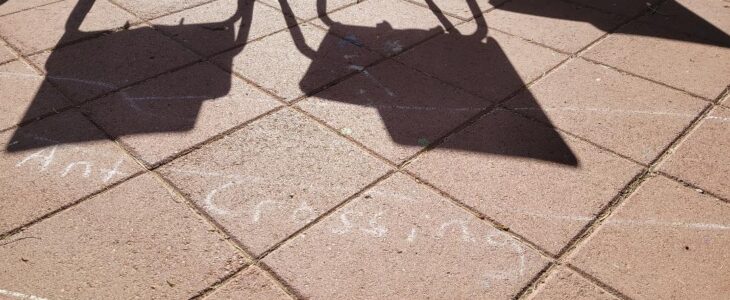
On a Wednesday night in October, I packed boxes bursting with plants, a bucket rattling with shovels, bags of heavy potting soil, and an assortment of plastic pots and seed packets. I remember choosing to wait until morning for the worksheets, pencils, and blankets… then forgetting to close the car door.
Jump to Thursday morning, a predictably dead car battery, and needing to leave for a gardening lesson in under two hours. How thankful I am that my husband Tim was not only up, but fluently speaks the language of cars. He calmly pulled out the right tools for my battery and kindly translated vocabulary for me. I finished getting the kids ready for school and myself ready to teach. Because of his comfort with vehicles and electricity, I could return to my greatest comfort – the language of gardening.
Connecting with plants and animals
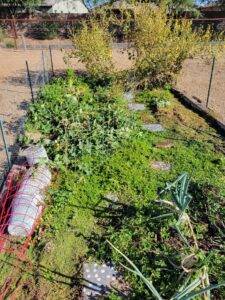
Gardening is what grounds me both personally and professionally. “Oh hello!” I fawn over snapdragon sprouts in a pot outside my front door. “Oh no, you need to move to the sunshine,” I say to the yellowed sweet alyssum that had been tucked beneath other plants. “Excuse me,” I say to the sprawling melon vines in the Marana Community Garden and decide to relocate the paver path. “Good morning!” I greet my public school gardens’ plants and birds before I meet people inside the building.
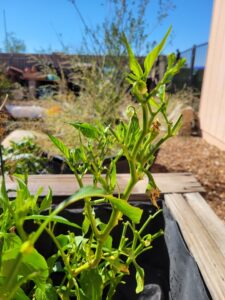
I connect with the little critters too. Orb weaver spiders create a gallery of webs to admire. I appreciate that grasshoppers and crickets speak to kids’ language of play. I allow a charismatic hornworm to munch most of the leaves and fruit from one pepper plant, and judge correctly that the remaining plants will be fine. (In fact, the caterpillar moved on or cocooned, and the munched plant re-grew.) I draw an “ant crossing” path in chalk across the ramada floor as a well-received truce between kindergarteners and insects. Long ago, my third grade self felt a deep sadness upon reading the poem “Forgotten Language” by Shel Silverstein. As I re-visit the text in the present, I feel hope that all is not lost: I tune in daily to birds and blooms and bugs. I keep learning, even if I’ll never know all the words.
Connecting past and present
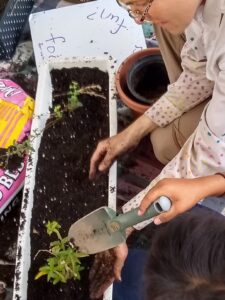
The intersection of past and present is a common theme in the language of gardening. Adult faces brighten from recognition of fruit trees they knew in childhood. Elementary students become a font of knowledge when writing garden-inspired recipes they have made with their parents. Past garden flops – have you planted crowded carrots? – lead to questions and trying anew. I regularly demonstrate transplanting a flower from its nursery pot to a larger container on a library patio. I regularly am transported back in time to my childhood front patio, learning the same skill from my mom. Gardening is a circular language.
Connecting people
Gardening is a language that connects people to each other. My own kids and friends know they can ask me about mint and marigolds and devil’s claw. My worms are invited to Cub Scout events, causing squeals of delight from Cubs and parents alike. They let me come too, isn’t that kind?
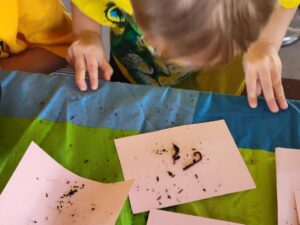
Further, gardening has become a way to meet and understand communities new to me. “Do you think it’s OK to keep my worm bin under my bed?” asked an enthusiastic library workshop participant who at the time was residing in a women’s shelter. From the worms’ perspective, I assured her it was fine. While I can’t speak for the shelter population, that conversation sure broadened my perspective of who benefits from Pima County Public Library programs. Individuals living out of their cars or spending their days on sidewalks similarly have expressed to me a hunger for growing a garden when they have a place to do so. Stories I’ve heard in parking lots before and after formal presentations are powerful reminders of the universal appeal of gardening.
In libraries, the Marana Community Garden, private backyards, and social media, I increasingly speak gardening with homeschool families too. In the days coming out the pandemic, planting sunflower seeds with a homeschool co-op and herbs with a homeschool family at a public program were as much a way to teach safely outside as to celebrate the community of learners. On a present-day October morning, many hands from one homeschooled family sank into the soil to try out watering techniques. I am thankful to be present and help add vocabulary – olla, basin, precipitation, perlite – for their joy and creativity. Online communities count, too. The Facebook group Wildschooling continually inspires my teaching methods plus has melted some lines I formerly drew between public and homeschool ideals. Gardening is a common thread among diverse lifestyles.
Connecting a battery, connecting different languages
Remember the car battery? Turns out it needed to be replaced, a service graciously provided at our neighborhood auto parts store. The gentleman helping my husband and me gave a routine reminder: disconnect the negative terminal first, and conversely connect the positive terminal first. He sounded like I do nearly daily in my school garden, but about the hose faucet: “Right is tight, left is loose.” I’m glad to be confident about gardening terms, techniques, and tools. And I keep in mind that, like me depending on someone else’ car expertise, what’s normal to me might be new to a gardening student. Even if you and I are at different fluencies, let’s keep learning about flowers and other wild wonders together.
